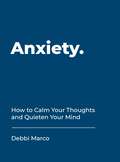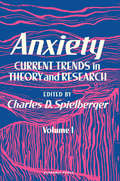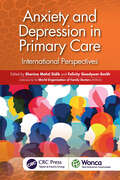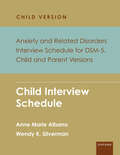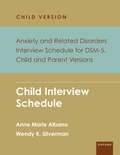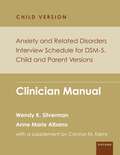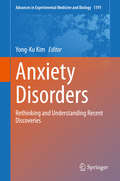- Table View
- List View
Anwendungsgebiete der Computertechnologie in Anaesthesie und Intensivmedizin (Anaesthesiologie und Intensivmedizin Anaesthesiology and Intensive Care Medicine #168)
by Hans Joachim Hartung P. M. Osswald H. J. BenderAnxiety: A Short History (Johns Hopkins Biographies of Disease)
by Allan V. HorwitzMore people today report feeling anxious than ever before—even while living in relatively safe and prosperous modern societies. Almost one in five people experiences an anxiety disorder each year, and more than a quarter of the population admits to an anxiety condition at some point in their lives. Here Allan V. Horwitz, a sociologist of mental illness and mental health, narrates how this condition has been experienced, understood, and treated through the ages—from Hippocrates, through Freud, to today.Anxiety is rooted in an ancient part of the brain, and our ability to be anxious is inherited from species far more ancient than humans. Anxiety is often adaptive: it enables us to respond to threats. But when normal fear yields to what psychiatry categorizes as anxiety disorders, it becomes maladaptive. As Horwitz explores the history and multiple identities of anxiety—melancholia, nerves, neuroses, phobias, and so on—it becomes clear that every age has had its own anxieties and that culture plays a role in shaping how anxiety is expressed.
Anxiety: A Short History (Johns Hopkins Biographies of Disease)
by Allan V. HorwitzMore people today report feeling anxious than ever before—even while living in relatively safe and prosperous modern societies. Almost one in five people experiences an anxiety disorder each year, and more than a quarter of the population admits to an anxiety condition at some point in their lives. Here Allan V. Horwitz, a sociologist of mental illness and mental health, narrates how this condition has been experienced, understood, and treated through the ages—from Hippocrates, through Freud, to today.Anxiety is rooted in an ancient part of the brain, and our ability to be anxious is inherited from species far more ancient than humans. Anxiety is often adaptive: it enables us to respond to threats. But when normal fear yields to what psychiatry categorizes as anxiety disorders, it becomes maladaptive. As Horwitz explores the history and multiple identities of anxiety—melancholia, nerves, neuroses, phobias, and so on—it becomes clear that every age has had its own anxieties and that culture plays a role in shaping how anxiety is expressed.
Anxiety: How to Calm Your Thoughts and Quieten Your Mind
by Debbi MarcoLife’s journey is not always smooth sailing, but there are ways of charting your own course. This compact book is packed with simple but effective tips and advice to ease your mind in times of turbulence, and help you find calm in every situation.
Anxiety: Current Trends in Theory and Research
by Charles D. SpielbergerAnxiety: Current Trends in Theory and Research, Volume I, seeks to facilitate a more comprehensive understanding of anxiety phenomena. This volume emerged from a symposium on Anxiety: Current Trends in Theory and Research held at Florida State University in the spring of 1970. The symposium brought together persons who have made important contributions to the understanding of anxiety phenomena and provided them with an opportunity to react to each other's ideas. One of the main goals of the symposium was to stimulate confrontation among opposing views with the expectation that this would, at least, provide clarification of terminology and eliminate the semantic confusion plaguing the field. The volume is organized into three parts. Part I presents an overview of the unique theoretical perspective and research objectives with which each contributor has approached the topic of anxiety. It also provides background information and historical perspective for the reader with limited familiarity with this area. Part II contains papers focusing on the nature and measurement of anxiety. Part III deals with the neurophysiological and biochemical aspects of anxiety. This work is intended primarily for psychologists and students of psychology, but it should be of interest to any behavioral or medical scientist concerned with a more comprehensive understanding of personality and psychopathology.
Anxiety and Anxiolytic Drugs (Handbook of Experimental Pharmacology #169)
by Florian Holsboer Andreas StröhleThe present volume gives a comprehensive overview on the current state of basic and clinical research on Anxiety and Anxiolytic Drugs. Using newly developed methods and techniques researchers are now beginning to understand the molecular mechanisms of anxiety, anxiety disorders and their treatment. In parallel, new drug targets have been generated and the first clinical studies with new compounds have been started. In 20 chapters written by numerous experts in the field comprehensive information on all relevant topics is provided.
Anxiety and Depression in Primary Care: International Perspectives (WONCA Family Medicine)
by Sherina Mohd Sidik Felicity Goodyear-SmithThis book provides practical information about depression and anxiety in primary care, with a focus on the approach in different countries and incorporating global ranges/prevalence, risk factors and health burden including that associated with COVID-19 and its pandemic. To ensure the challenges of a wide international primary care community are reflected fully, authors from different world regions – Africa, Asia Pacific, East Mediterranean, Europe, IberoAmericana-CIMF, North America and South Asia – have co-contributed to individual chapters on the detection and management of depression and anxiety in primary care in their own countries, including the screening tools used, how widely these tools are adopted and by whom, and current policies. As well as the medical model, it also presents the alternative viewpoint that feeling low or anxious is part of the human condition and the attention should be on supporting people in their journey through life, struggling to deal with the mainly social challenges they meet, rather than defining these problems as disorders or diseases requiring identification and treatment. Key Features: Explores the instruments used for the detection of depression and anxiety in primary care in various countries, and why and how these instruments are being used Describes the pharmaceutical and non-drug interventions for treating depression and anxiety in primary care and compares the similarities and differences in detecting and managing depression and anxiety in primary care among different countries Includes in-depth regional examples of how screening tools are used in practice and how policies can be established in the management of depression and anxiety in primary care Concludes with lessons learned from various countries and from different stakeholders with clear advice on what to do and, importantly, what not to do Addressing primary care detection and management of mental health issues across the globe, the book will be an invaluable practical aid for family medicine practitioners and the wider primary and community care teams and a useful reference for those involved in policy setting at regional and national levels including ministries of health.
Anxiety and Depression in Primary Care: International Perspectives (WONCA Family Medicine)
by Sherina Mohd Sidik Felicity Goodyear-SmithThis book provides practical information about depression and anxiety in primary care, with a focus on the approach in different countries and incorporating global ranges/prevalence, risk factors and health burden including that associated with COVID-19 and its pandemic. To ensure the challenges of a wide international primary care community are reflected fully, authors from different world regions – Africa, Asia Pacific, East Mediterranean, Europe, IberoAmericana-CIMF, North America and South Asia – have co-contributed to individual chapters on the detection and management of depression and anxiety in primary care in their own countries, including the screening tools used, how widely these tools are adopted and by whom, and current policies. As well as the medical model, it also presents the alternative viewpoint that feeling low or anxious is part of the human condition and the attention should be on supporting people in their journey through life, struggling to deal with the mainly social challenges they meet, rather than defining these problems as disorders or diseases requiring identification and treatment. Key Features: Explores the instruments used for the detection of depression and anxiety in primary care in various countries, and why and how these instruments are being used Describes the pharmaceutical and non-drug interventions for treating depression and anxiety in primary care and compares the similarities and differences in detecting and managing depression and anxiety in primary care among different countries Includes in-depth regional examples of how screening tools are used in practice and how policies can be established in the management of depression and anxiety in primary care Concludes with lessons learned from various countries and from different stakeholders with clear advice on what to do and, importantly, what not to do Addressing primary care detection and management of mental health issues across the globe, the book will be an invaluable practical aid for family medicine practitioners and the wider primary and community care teams and a useful reference for those involved in policy setting at regional and national levels including ministries of health.
Anxiety and Panic: How to reshape your anxious mind and brain (The Flag Series #1)
by Dr Harry BarryTHE NUMBER 1 INTERNATIONAL BESTSELLERA practical guide to understanding, managing and overcoming anxiety and panic attacks by bestselling author and GP Harry Barry. Do you or does someone you love suffer from general anxiety, social anxiety, panic attacks, a phobia, obsessive-compulsive disorder or post-traumatic stress disorder? Or are you a health-care worker treating people with these disorders? Then this book is for you. Dr Harry Barry combines a deep knowledge of the inner workings of the mind and brain with a wealth of experience treating patients as a GP to offer a way out of the fear, worry and shame of anxiety. In this wise, supportive book, Dr Barry explains clearly and simply what it is about our minds and brains that generates the symptoms of anxiety. Through a series of case studies based on his real-life experiences treating patients, he explains and demonstrates how to use lifestyle changes, mindfulness, exercise and CBT techniques to cope with these symptoms and ultimately feel better.Previously published as Flagging Anxiety: How to Reshape Your Anxious Mind and Brain, this edition has been fully revised and updated.
Anxiety and Related Disorders Interview Schedule for DSM-5, Child and Parent Version: Child Interview Schedule - 5 Copy Set (PROGRAMS THAT WORK)
by Anne Marie Albano Wendy K. SilvermanThe Anxiety Disorders Interview Schedule for DSM-5, Child and Parent Versions, are the gold standard semi-structured interviews used in clinical research and services to assess and diagnose the major mental health conditions affecting children, adolescents and young adults. These interviews cover the range of conditions identified in the Diagnostic and Statistical Manual of Mental Disorders (DSM), while also providing information for careful case formulation in treatment planning and evaluation of outcomes. Evaluators are able to quantify the severity of illness using a Clinician Severity Rating (CSR), as well as level of severity of symptoms and associated avoidance behavior. Decision rules for combining parent and youth reports, examples of CSR levels for the child anxiety triad of separation anxiety disorder, social anxiety disorder, and generalized anxiety disorder are included in the Clinician Guide. Price is for a set of 5 Child Interview Schedules.
Anxiety and Related Disorders Interview Schedule for DSM-5, Child and Parent Version: Child Interview Schedule - 5 Copy Set (PROGRAMS THAT WORK)
by Anne Marie Albano Wendy K. SilvermanThe Anxiety Disorders Interview Schedule for DSM-5, Child and Parent Versions, are the gold standard semi-structured interviews used in clinical research and services to assess and diagnose the major mental health conditions affecting children, adolescents and young adults. These interviews cover the range of conditions identified in the Diagnostic and Statistical Manual of Mental Disorders (DSM), while also providing information for careful case formulation in treatment planning and evaluation of outcomes. Evaluators are able to quantify the severity of illness using a Clinician Severity Rating (CSR), as well as level of severity of symptoms and associated avoidance behavior. Decision rules for combining parent and youth reports, examples of CSR levels for the child anxiety triad of separation anxiety disorder, social anxiety disorder, and generalized anxiety disorder are included in the Clinician Guide. Price is for a set of 5 Child Interview Schedules.
Anxiety and Related Disorders Interview Schedule for DSM-5, Child and Parent Version: Clinician Manual (PROGRAMS THAT WORK)
by Wendy K. Silverman Anne Marie AlbanoThe Anxiety Disorders Interview Schedule for DSM-5, Child and Parent Versions, are the gold standard semi-structured interviews used in clinical research and services to assess and diagnose the major mental health conditions affecting children, adolescents and young adults. These interviews cover the range of conditions identified in the Diagnostic and Statistical Manual of Mental Disorders (DSM), while also providing information for careful case formulation in treatment planning and evaluation of outcomes. Evaluators are able to quantify the severity of illness using a Clinician Severity Rating (CSR), as well as level of severity of symptoms and associated avoidance behavior. Decision rules for combining parent and youth reports, examples of CSR levels for the child anxiety triad of separation anxiety disorder, social anxiety disorder, and generalized anxiety disorder are included in the Clinician Guide, as well as detailed information on use of the Autism Supplement. This item includes one Clinician Manual.
Anxiety and Related Disorders Interview Schedule for DSM-5, Child and Parent Version: Clinician Manual (PROGRAMS THAT WORK)
by Wendy K. Silverman Anne Marie AlbanoThe Anxiety Disorders Interview Schedule for DSM-5, Child and Parent Versions, are the gold standard semi-structured interviews used in clinical research and services to assess and diagnose the major mental health conditions affecting children, adolescents and young adults. These interviews cover the range of conditions identified in the Diagnostic and Statistical Manual of Mental Disorders (DSM), while also providing information for careful case formulation in treatment planning and evaluation of outcomes. Evaluators are able to quantify the severity of illness using a Clinician Severity Rating (CSR), as well as level of severity of symptoms and associated avoidance behavior. Decision rules for combining parent and youth reports, examples of CSR levels for the child anxiety triad of separation anxiety disorder, social anxiety disorder, and generalized anxiety disorder are included in the Clinician Guide, as well as detailed information on use of the Autism Supplement. This item includes one Clinician Manual.
Anxiety, Depression, and Emotion (Series in Affective Science)
by Richard J. DavidsonThis unique volume focuses on the relationship between basic research in emotion and emotional dysfunction in depression and anxiety. Each chapter is authored by a highly regarded scientist who looks at both psychological and biological implications of research relevant to psychiatrists and psychologists. And following each chapter is engaging commentary that raises questions, illuminates connections with other bodies of work, and provides points of integration across different research traditions. Topics range from stress, cognitive functioning, and personality to affective style and behavioral inhibition, and the book as a whole has significant implications for understanding and treating anxiety disorders.
Anxiety Disorders: Pathophysiology and Pharmacological Treatment
by Gerard Emilien Cecile Durlach Ulla Lepola Timothy DinanIn this book, the discussion of the normal and pathological aspects of anxiety is critically examined. A chapter on the molecular basis of anxiety is included, outlining the potential of such approach in the discovery of novel effective pharmacological interventions. The face validity, predictability and usefulness of animal models in the design of valid new efficacious products are discussed. Separate chapters dedicated to each particular type of anxiety such as generalized anxiety disorder, social phobia, posttraumatic stress disorder, panic and obsessive-compulive disorder are included. This book should be of benefit to psychiatrists, clinical psychologists, general practitioners, nurses, students and all those engaged in neuropsychiatric research.
Anxiety Disorders (Primer On)
by Kerry J. Ressler, Daniel S. Pine and Barbara Olasov RothbaumAnxiety affects millions, manifesting as generalized anxiety disorder (GAD), obsessive compulsive disorder, panic disorder, phobias, post-traumatic-stress disorder (PTSD), and social anxiety disorder. Not only are anxiety disorders common, but they are also crippling, frequently co-occurring and predict high risk for depressive disorders. Shared mechanisms may explain the overlapping features of many anxiety disorders and account for associations with other highly-impairing conditions, such as major depression and substance use. Beyond risk for specific disorders, anxiety also predicts a number of other adverse outcomes, including suicidal behavior, medical problems, social, and economic difficulties. Conversely, disorder-specific mechanisms may also exist and explain the unique features of each syndrome. Thus, it is important to understand both shared and specific aspects of anxiety. The Primer on Anxiety Disorders provides early-stage practitioners and trainees, as well as seasoned clinicians and researchers, with need-to-know knowledge on diagnosis and treatment. Clinical cases are used throughout the book to enhance understanding of and illustrate specific disorders, comorbid conditions and clinical issues. To facilitate an integrative approach, content allows clinicians to understand patient characteristics and tailor interventions. The integrated approach of each chapter includes recent research on genetics and neuroscience to understand the mechanisms of anxiety disorders, focusing on the forthcoming new nosology in DSM-5. Chapters further integrate innovative advances in clinical research providing research on a range of discoveries regarding biomarkers of illness, biological predictors of treatments and the effect of treatment on neurocircuitry.
Anxiety Disorders: Rethinking and Understanding Recent Discoveries (Advances in Experimental Medicine and Biology #1191)
by Yong-Ku KimThis book reviews all important aspects of anxiety disorders with the aim of shedding new light on these disorders through combined understanding of traditional and novel paradigms. The book is divided into five sections, the first of which reinterprets anxiety from a network science perspective, examining the altered topological properties of brain networks in anxiety disorders. The second section discusses recent advances in understanding of the neurobiology of anxiety disorders, covering, for example, gene-environmental interactions and the roles of neurotransmitter systems and the oxytocin system. A wide range of diagnostic and clinical issues in anxiety disorders are then addressed, before turning attention to contemporary treatment approaches in the context of novel bio-psychosocial-behavioral models, including bio- and neurofeedback, cognitive behavioral therapy, neurostimulation, virtual reality exposure therapy, pharmacological interventions, psychodynamic therapy, and CAM options. The final section is devoted to precision psychiatry in anxiety disorders, an increasingly important area as we move toward personalized treatment.Anxiety Disorders will be of interest for all researchers and clinicians in the field.
Anxiety Disorders
by David J. Nutt James C. BallengerRapid developments in recent years in basic science and pharmacology has greatly increased understanding of the causes of anxiety disorders. This has led to a large number of new drug treatments from the pharmaceutical industry. This book makes sense of these advances and presents a coherent account of diagnosis and management from the clinical point of view. Chapters are in the form of surveys and digests of the recent literature and are interspersed with clinical guidelines, diagnostic and therapeutic points and are well illustrated.
Anxiety Disorders: A Guide for Integrating Psychopharmacology and Psychotherapy (Clinical Topics in Psychology and Psychiatry)
by Stephen M. Stahl Bret A. MooreDrs. Stephen M. Stahl and Bret A. Moore have created an instant classic in Anxiety Disorders: A Guide for Integrating Psychopharmacology and Psychotherapy. Anxiety Disorders is a comprehensive reference for the psychiatry and psychology student, intern, or resident, early career psychiatrist or psychologist, and the busy clinician. It distills the most important information regarding combined treatments for anxiety and presents the material in an easily accessible, understandable, and readable format. Each chapter addresses a specific type of disorder: PTSD, panic, generalized anxiety, obsessive-compulsive and other disorders, and is authored by prominent clinicians with years of experience in providing integrated, individualized treatments. With its thorough exploration of psychopharmacological treatments, psychosocial treatments, and, crucially, the integration of the two, Anxiety Disorders is a text no 21st-century clinician or student can afford to be without.
Anxiety Disorders: A Guide for Integrating Psychopharmacology and Psychotherapy (Clinical Topics in Psychology and Psychiatry)
by Stephen M. Stahl Bret A. MooreDrs. Stephen M. Stahl and Bret A. Moore have created an instant classic in Anxiety Disorders: A Guide for Integrating Psychopharmacology and Psychotherapy. Anxiety Disorders is a comprehensive reference for the psychiatry and psychology student, intern, or resident, early career psychiatrist or psychologist, and the busy clinician. It distills the most important information regarding combined treatments for anxiety and presents the material in an easily accessible, understandable, and readable format. Each chapter addresses a specific type of disorder: PTSD, panic, generalized anxiety, obsessive-compulsive and other disorders, and is authored by prominent clinicians with years of experience in providing integrated, individualized treatments. With its thorough exploration of psychopharmacological treatments, psychosocial treatments, and, crucially, the integration of the two, Anxiety Disorders is a text no 21st-century clinician or student can afford to be without.
Anxiety Disorders: A Pocket Guide For Primary Care (Current Clinical Practice)
by John Vanin James HelsleyThis pocket guide is designed to help the primary care practitioner recognize, diagnose, and manage anxiety disorders in a busy clinical practice. It presents an easy-to-follow, step-by-step approach, and offers practical points based on both real patient-care experience and review of current medical literature. The guide includes helpful chapters on psychopharmacology, psychopharmacotherapy, and psychologic treatment for the anxiety disorders.
Anxiety Disorders (Primer On)
Anxiety affects millions, manifesting as generalized anxiety disorder (GAD), obsessive compulsive disorder, panic disorder, phobias, post-traumatic-stress disorder (PTSD), and social anxiety disorder. Not only are anxiety disorders common, but they are also crippling, frequently co-occurring and predict high risk for depressive disorders. Shared mechanisms may explain the overlapping features of many anxiety disorders and account for associations with other highly-impairing conditions, such as major depression and substance use. Beyond risk for specific disorders, anxiety also predicts a number of other adverse outcomes, including suicidal behavior, medical problems, social, and economic difficulties. Conversely, disorder-specific mechanisms may also exist and explain the unique features of each syndrome. Thus, it is important to understand both shared and specific aspects of anxiety. The Primer on Anxiety Disorders provides early-stage practitioners and trainees, as well as seasoned clinicians and researchers, with need-to-know knowledge on diagnosis and treatment. Clinical cases are used throughout the book to enhance understanding of and illustrate specific disorders, comorbid conditions and clinical issues. To facilitate an integrative approach, content allows clinicians to understand patient characteristics and tailor interventions. The integrated approach of each chapter includes recent research on genetics and neuroscience to understand the mechanisms of anxiety disorders, focusing on the forthcoming new nosology in DSM-5. Chapters further integrate innovative advances in clinical research providing research on a range of discoveries regarding biomarkers of illness, biological predictors of treatments and the effect of treatment on neurocircuitry.
Anxiety Disorders and Gender
by Dan J. Stein Bavi VythilingumAnxiety and related disorders are common conditions that disproportionately affect women. In this book, the epidemiology, psychobiology, diagnosis, evaluation, pharmacotherapy and psychotherapy of major anxiety and related disorders are examined with special reference to the effects of gender and sex on clinical presentation and treatment. The conditions considered include generalized anxiety disorder, obsessive-compulsive disorder, panic disorder, posttraumatic stress disorder and social anxiety disorder. In addition, the management of anxiety and related disorders during pregnancy and lactation are discussed. Two concluding chapters specifically address anxiety disorders in women and in men, summarizing key points for clinicians and researchers. The authors are leading clinicians, including both psychiatrists and psychologists, from around the globe.
Anxiety Disorders in Adults: An Evidence-Based Approach to Psychological Treatment (Guidebooks in Clinical Psychology)
by Peter D. McLean Sheila R. WoodyRecently developed psychosocial treatments for anxiety disorders reflect the systematic influence of scientifically generated knowledge, and these new treatments yield strong results. Research in such areas as information processing, cognition, behavioral avoidance, and the physiological components of anxious arousal has increased our knowledge of mediators that cause and maintain anxiety disorders. The development of these new clinical tools is timely, as epidemiological studies now show that up to 25% of people will experience at least one anxiety disorder in their lifetime. Meanwhile, mental health care providers are increasingly pressured to limit the number of sessions and use demonstrably effective treatments. In this book, the authors review psychosocial treatments for anxiety disorders, focusing on the scientific basis and demonstrated outcomes of the treatments. Cognitive behavioral therapies are highlighted, as they have been the most frequently investigated approaches to treating anxiety disorders. Individual chapters feature specific phobias: social phobia, panic disorder, and generalized anxiety disorder. The book is rich in clinical material and integrates science and clinical practice in an effort to help practitioners to improve the effectiveness of their work with anxious clients.
Anxiety Disorders in Adults A Clinical Guide
by Vladan Starcevic, MD, PhDUsing the practical yet comprehensive approach found in the first edition, the author considers each anxiety disorder's clinical complexity while simultaneously using an integrative orientation toward finding clinical solutions. The author considers the presentation of each disorder as it occurs and is treated in the "real world" of clinical practice. Finally, the volume addresses effective therapeutic procedures and recommendations, including pharmacological and psychological treatment approaches. A true "must read" for any psychiatrist interested in anxiety disorders.


